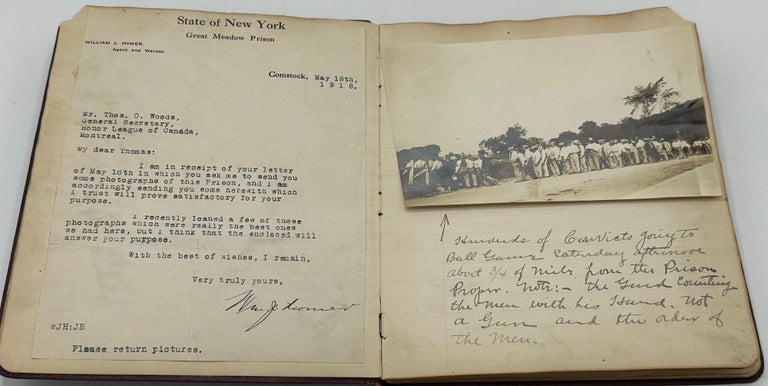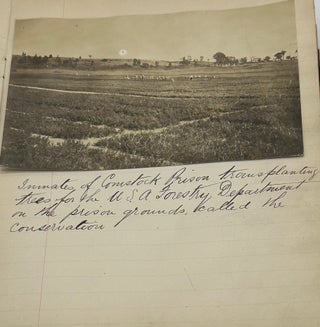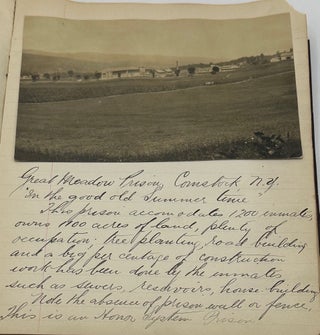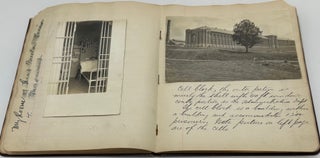NEW YORK'S WOULD-BE MODEL PRISON, as pictured in a photograph album containing 17 original silver gelatin prints on glossy paper, tipped in, with full manuscript descriptions.
Comstock, NY: 1918. Small 4to (22 cm.). 17 leaves with mounted photographs, each 4 1/8 x 6 3/8 inches, picturing various buildings, activities, including prisoners at work, interior and outdoor scenes, etc. Typed letter, signed by William J. Homer, the Warden at Great Meadow Prison in Comstock, N.Y., forwarding the photographs to Thomas O. Woods, General Secretary of the Honor League of Canada in Montreal, tipped to verso of front endpaper; with Woods's ownership signature on the front endpaper. During the 1920s this would-be model prison in Washington County, N.Y., was converted to a maximum-security prison for hardened criminals; it is in the news today for repeated violent incidents resulting in lockdowns. In 1918 it was under the care of a progressive prison warden whose dream was a prison without walls. It had none then; but the walls were under construction by 1926, seven years after Homer's passing. His mission had been the reform of first-time offenders and other manageable prisoners, giving inmates constructive work, recreation, a civilized living environment, and a message of trust. The letter from Homer to Woods asks that the photographs be returned, but they were not; instead Woods made them his own, constructing this album. The photographs, every one fully described in ink manuscript, depict recreation (e.g., inmates attending a nearby afternoon ball game); work projects (e.g., inmates transplanting trees, road building, with the comment, "note the absence of guns, stripes, and the guard on the opposite side of the fence"); a view noting "the absence of prison wall or fence. This is the honor system"; buildings nearing completion; "Men taking sun bath during dinner hour. The prison is situated in the foot hills of the Adirondacks"; a picture of a very tidy cell, walls adorned with photographs; "An officer's quarters under construction by inmates" (this is not chain gang labor, the men are practicing trade skills); a garage near completion; "Homer Avenue, named after the warden ... the domiciles of the officers of the prison ... the road-way cement sidewalks, cement block houses built by the inmates ... one-third less than contract price"; "Mess Hall ... a man has a chance to develop self-respect, even if he never had any"; "Another view of the Mess Hall ... the N.Y. State penal authorities have come to the conclusion that the mess hall system ... is the only way to feed inmates whereas in Canada the food is thrown at prisoners in their cells. Canadian prisoners they sleep and they eat. They idle and they weep, and their cell is nothing more than a kennel." The Library of Congress has four earlier images and an 11 postcards depicting the prison. The images here seem to be unique. An image of Homer at the Library of Congress notes his passing in 1919; with him died the aspiration for a humane facility. Reports of multiple inspections made by state officials in 1914 give it rave reviews; the prison population was around 600. Homer's work received national recognition in the periodical press and in scholarly journal literature. He served as warden from 1911 to the time of his death, one year after this album was assembled. Unrelated pencil notes and marking to the verso of one leaf, corner edges of three images with small turn-ins at hinge, and the "chewing noted, but an excellent vernacular photo essay documenting a failed effort at prison reform in New York. Burgundy limp-leather covered blank book (upper corner chewed, only slightly affecting a the final photograph), gilt-stamped "M&S" on front board. (11124). Item #64916
Price: $1,750.00




